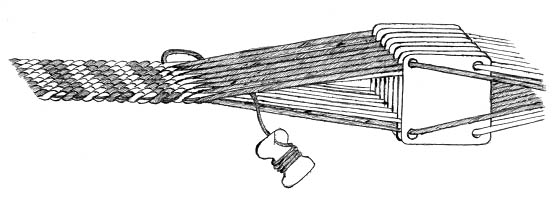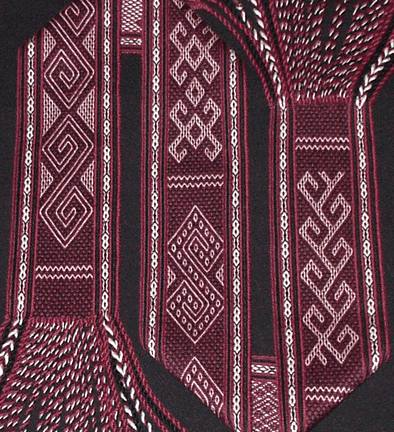Difference between revisions of "Tablet Weaving"
m (added category) |
|||
| Line 20: | Line 20: | ||
*[http://www.lindahendrickson.com/ Gallery and Links of Card weaving] | *[http://www.lindahendrickson.com/ Gallery and Links of Card weaving] | ||
[[Category:Trims]] [[Category:Amtgard Things]] [[Category:Arts and Sciences]] [[Category:How To]] | [[Category:Trims]] [[Category:Amtgard Things]] [[Category:Arts and Sciences]] [[Category:How To]] | ||
| + | [[Category:Unformatted Resources]] | ||
Revision as of 03:05, 30 March 2016

Tablet weaving, also know as Card weaving, is a method of producing narrow textiles such as straps, belts and trim. Most card woven bands are very strong and sturdy. Card woven bands can range from simple and easy to elaborately patterned and very time consuming. I'll focus on the easiest types, but I will tell you where to find out more about the more complicated types of card weaving.
The oldest known reliable evidence for card weaving comes from about 400 B.C. Several cards and some card woven material was found at an archeological site in Spain. In period, card weaving was most highly developed in northern Europe, especially in Scandinavia, and was also used by the Anglo-Saxons. Many medieval pieces were ornate silk ecclesiastical vestments, or wrist and head bands brocaded with gold or silver, but others were much simpler. These may have been used as belts or straps. Card woven borders were sometimes woven into larger textiles. This helped to set the warp spacing and provided sturdy selvages.
Links
- Video of Card Weaving
- Basic Tablet Weaving
- Introduction with hw to on magin your own cards
- Tablet Weaving Archive
- Article on Tablet Weaving
- How to table weaving
- Saxon threaded in Tablet weave
- Pattern from Extant Tablet woven band
- Saxon belt pattern
- Ren Talior
- Purchase Cards
- Gallery and Links of Card weaving
